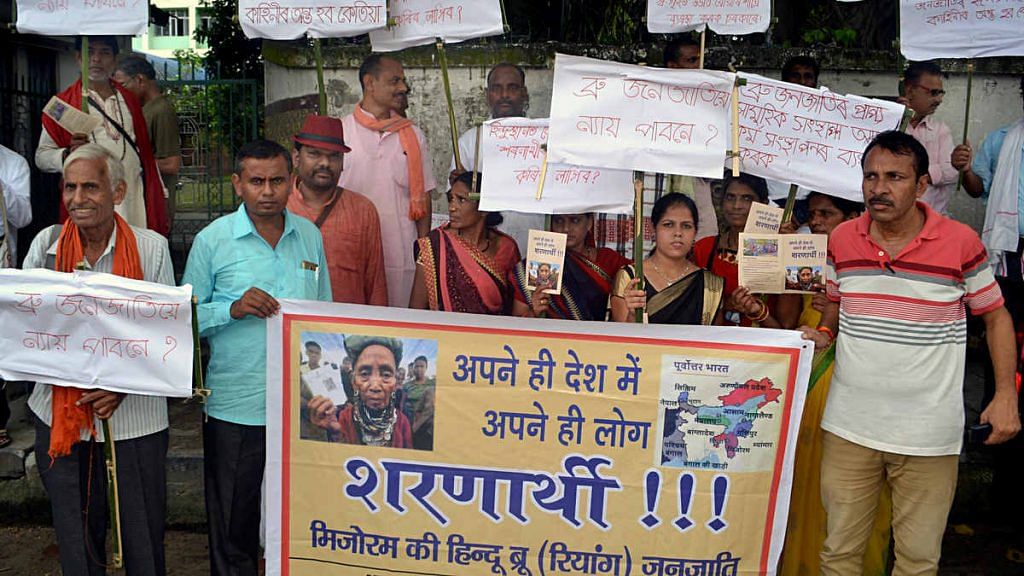Aizawl: On 3 October, the Union Ministry of Home Affairs, along with the state governments of Tripura and Mizoram, began the ninth attempt to repatriate more than 30,000 internally-displaced people from the Bru community from six relief camps in north Tripura, where they have been living for over two decades now.
However, like the previous ones, this attempt, which is set to conclude on 30 November, too seems to be heading towards futility, with only about 125 families having returned to Mizoram so far. This, despite the central government announcing cash doles, land allocations and insisting that this would be the last such attempt.
Brus have protested several times against the attempted repatriation in the three weeks since it began, and have also petitioned Union Home Minister Amit Shah with various demands. Community leaders, in fact, had agreed to plans adopted by a joint committee of representatives of the three governments, relief camp leaders, Bru leaders in Mizoram itself and Mizo groups, but later revoked that agreement.
ThePrint explains who the Bru people are, why they are refugees in Tripura, and why they are being repatriated.
Also read: Why first phase of Bru refugee movement from Tripura to Mizoram failed
Who are the Bru people?
The Bru community is known by different names and its members are spread over at least three north-eastern states — Tripura, Mizoram and parts of southern Assam.
The Brus are ethnically distinct from the Mizos, and the two tribes speak mutually unintelligible languages/dialects, unlike Mizos and Kukis, who share close linguistic and cultural ties and were usually referred to as Kuki-Lushai tribes in colonial times (Lushai or Lusei is the most prominent clan in what is now the Mizo community).
In Tripura, where the Brus are the most populous tribe after the Tripuris, they are known as Reangs, and were almost 2 lakh strong during the 2011 Census. In Mizoram, they are largely referred to by other tribes as ‘Tuikuk’. But in the past two decades or so, they have been increasingly referred to as Bru, a nomenclature of their own choosing.
There are over 40,000 Brus living in four districts of Mizoram, while about 32,000 Brus from Mizoram currently reside in relief camps in northern Tripura.
Also read: Mizoram might be small, but it offers us big lessons in peacemaking
What made them flee to Tripura?
About half the Bru population in Mizoram fled to Tripura in 1997 following ethnic clashes with the Mizos. That year, Bru leaders had demanded an Autonomous District Council (ADC) for the tribe under the 6th Schedule of the Constitution in the western areas of Mizoram, where they were present in sizable numbers but where Mizos formed the majority.
While there were verbal duels between Mizo and Bru groups, a hitherto unknown Bru militant group, calling itself the Bru National Liberation Front, kidnapped and murdered a Mizo forest department employee in the Dampa Tiger Reserve.
The killing led to an upheaval, and Bru thatched huts in several villages in Mizoram’s western periphery were burnt by enraged Mizo villagers. The Brus, egged on by their leaders, fled to Tripura over several months, despite exhortations from political leaders and officials not to.
Also read: The jugular as the Achilles’ heel
Why are they being repatriated?
Tripura is keen that the Brus return to Mizoram, since they add to the sizeable tribal population, and because the land occupied by the relief camps is owned by domicile tribals.
The MHA foots the bill and oversees the task of repatriation, while the Tripura and Mizoram governments handle the exercise on the ground.
The current repatriation is the ninth attempt to bring back Brus to Mizoram, the first having taken place as long ago as 2000. The eight previous attempts have been less than successful, with just over 9,000 Brus returning. The Centre has labelled this the final attempt at repatriation, but then again, each attempt since 2013 has been called that.
As early as 2010, the Centre had concurred with both the Mizoram and the Tripura governments that “unscrupulous elements of the relief camps of Tripura” were attempting to derail the repatriation attempt. In 2013, the ministry began to state it would stop doling out rations to relief camp inmates who did not take part in the repatriation, and presume “they are no more refugees”.
The current attempt too is likely to be unsuccessful, as some relief camp Bru groups have reportedly rekindled demands for an ADC. Most recently, a consortium of groups this week marched 15 km in protest from the relief camps to a northern Tripura town, and demanded Mizoram cease sending vehicles to transport them as part of the repatriation attempt. The vehicles have largely returned empty, as only 125 families have been repatriated in this attempt.
Also read: Mizoram PMAY beneficiaries have congratulatory letters but no houses, state dept is ‘sorry’
